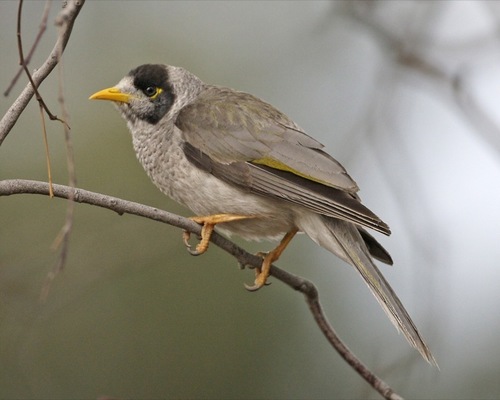
Noisy Miner
The Noisy Miner (*Manorina melanocephala*) is a bold and highly social honeyeater native to eastern and southeastern Australia. Known for their aggressive territorial behavior and complex social structures, Noisy Miners play a significant role in shaping the avian communities where they occur. They often exclude smaller bird species from their territories, impacting local biodiversity. While not widely celebrated due to their aggressive nature, they are a fascinating example of a species that has adapted well to both natural and human-modified environments.
24-28 cm
Length
36-45 cm
Wingspan
Least Concern
Conservation Status
Distribution
Eastern and southeastern Australia, from Queensland through New South Wales and Victoria to Tasmania and parts of South Australia. They are generally non-migratory, though some local movements may occur in response to food availability.
Lifespan
Up to 15 years or more in the wild has been recorded, but the average lifespan is likely shorter.
Noisy Miner's Habitat
Habitat Types
Open woodlands, Dry sclerophyll forests, Urban parks and gardens, Farmlands with scattered trees
Climate Zones
Temperate, Subtropical, Mediterranean
Adaptations
Noisy Miners thrive in disturbed habitats and edge environments, often benefiting from human-altered landscapes that provide open areas with scattered trees. Their adaptability to a variety of food sources also contributes to their success.
Variations
No significant subspecies are currently recognized, although there is some regional variation in plumage darkness and size.
Appearance
Breeding Plumage
No significant difference between breeding and non-breeding plumage.
Seasonal Feather Changes
None
Sex Based Plumage Differences
Males and females have similar plumage.
Notable Features
Grey body with a darker grey-black head, Distinctive yellow patch behind the eye, Yellow bill and legs, White-tipped tail feathers
Diet and Feeding
Primary Foods
Nectar, Insects, Fruits, Lerps (insect secretions)
Foraging Behavior
Noisy Miners are active and versatile foragers. They glean insects and lerps from foliage, probe flowers for nectar, and occasionally hawk for flying insects. They often forage in groups, cooperatively defending their feeding territories.
Specializations
Their brush-tipped tongue is adapted for extracting nectar from flowers. Their strong legs and feet allow them to cling to branches while foraging.
Seasonal Diet Variations
The proportion of nectar, insects, and fruit in their diet varies seasonally depending on availability. Nectar may be more important during flowering seasons, while insects are consumed year-round.
Behavior
Social Structure
Noisy Miners live in complex social groups called colonies or coteries, which can consist of dozens or even hundreds of birds. Within the colony, there are smaller family units and breeding territories.
Communication
Loud, harsh calls (hence the name 'Noisy' Miner), Variety of chattering and scolding calls, Wing and body postures for visual communication
Migration
Generally non-migratory, but may undertake local movements in response to food availability or drought conditions.
Territorial or Group Behaviors
Highly territorial and aggressive, especially towards other bird species. They cooperatively mob predators and relentlessly harass other birds that enter their territory, often excluding smaller species.
Conservation
Threats
Habitat loss and fragmentation (although they adapt well to some modified habitats), Increased competition with other species due to habitat changes, Negative impact on other bird species through aggressive exclusion
Protection Programs
None specifically targeted at Noisy Miners due to their 'Least Concern' status and sometimes detrimental impact on other species.
Local National Laws
Protected under general wildlife legislation in Australia, but not subject to specific conservation management.
Population Trend
Stable
Population Estimates
Abundant and widespread; population estimates are not precisely quantified but are considered to be in the millions.
Interesting Facts
They are one of the few native Australian birds that have benefited from some forms of human land clearing.
The creation of open woodlands and edges has increased their preferred habitat.
Their aggressive behavior can significantly reduce local bird diversity.
Studies have shown that the presence of Noisy Miners can lead to the decline or absence of smaller bird species in an area.
They are known to mob and attack much larger birds, including raptors.
This cooperative defense helps protect their colony from predators.
Faqs about Noisy Miner
Why are Noisy Miners so aggressive?
Their aggression is a territorial defense mechanism. They fiercely protect their food resources and nesting sites, especially from other birds that compete for the same resources.
Are Noisy Miners a pest species?
While they are native to Australia, their aggressive behavior and impact on other bird species can sometimes lead to them being considered a nuisance, especially in urban areas.
What can I do to discourage Noisy Miners from my garden?
Creating a dense, multi-layered garden with a variety of native plant species can help attract smaller birds and make the area less appealing to Noisy Miners, who prefer more open habitats.
Do noisy miner birds mate for life?
Noisy miners do not mate for life. They are cooperative breeders.
Copyright @ Nature Style Limited. All Rights Reserved.
 English
English